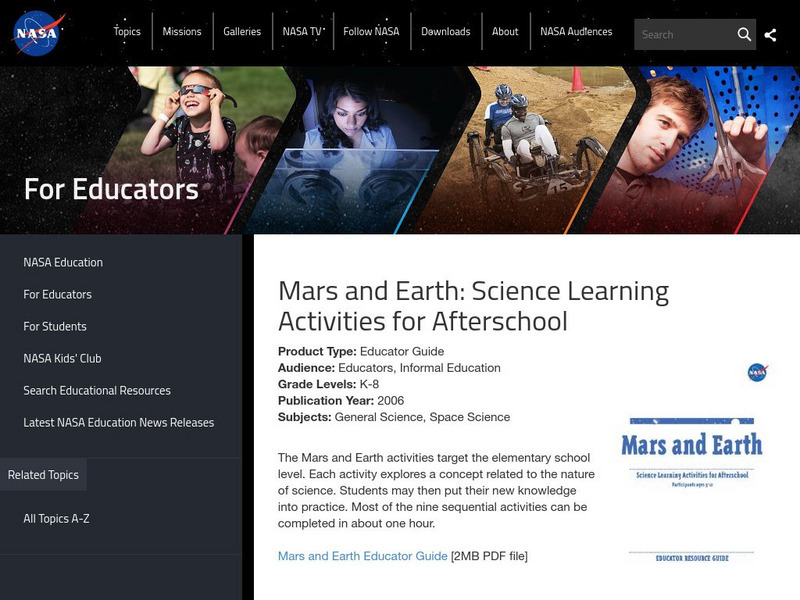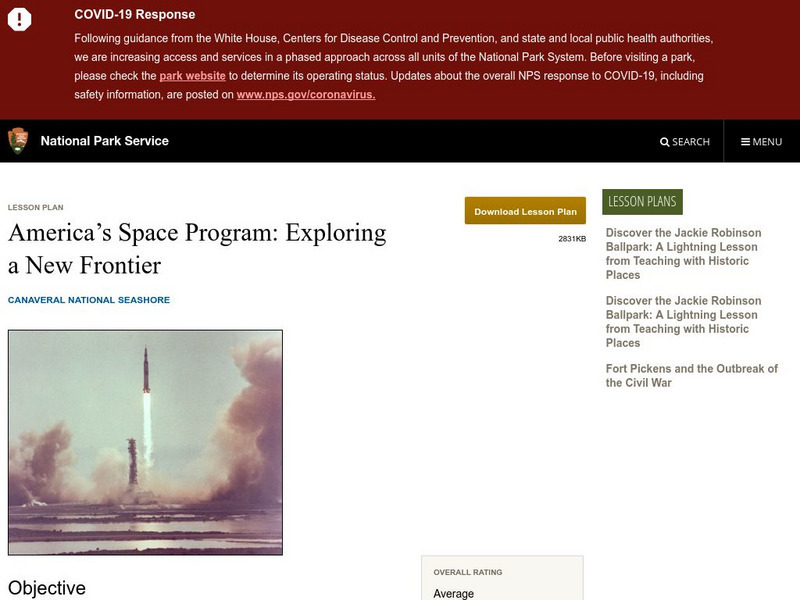Hi, what do you want to do?
Curated OER
The Rubber Band Problem
Students work in groups and view a rubber band demonstration. In this friction lesson students then complete the experiment themselves.
Curated OER
Newton Car
Students demonstrate Newtons law of motion by examining the reaction of a rolling car when its mass and acceleration is increased. In this acceleration lesson students complete and activity that shows them how Newtons Law of Motion...
Curated OER
A Tough Nut to Crack
Students study the origins and background of the pecan. In this agriculture lesson students divide into groups, complete an activity and worksheets.
Curated OER
Why is the Average Temperature Greater on Venus than on Mercury?
Students examine the reasons why the temperature is higher on Venus than on Mercury. In groups, they analzye both planet's atmospheres and determine the rate of global warming on each. They use the internet to research the planets in...
NASA
Nasa: An Educator's Guide to the Engineering Design Process: K 2 [Pdf]
The NASA BEST Activities Guides were designed to teach students the Engineering Design Process. This is one of three guides targeting different grade groups. All follow the same set of activities and teach students about humans' endeavor...
NASA
Nasa: Mars and Earth: Science Learning Activities for Afterschool
This set of activities teaches students about the big picture of science using Mars as an example: how to collect data, use evidence, and look at models.
NASA
Nasa: Trends of Snow Cover and Temperature in Alaska
This lesson plan allows learners to use NASA satellite data observations with surface measurements of snow in Alaska. Students will be able to make scientific predictions, find data correlations, and learn about data collection methods.
NASA
Nasa: Using Radiosonde Data From a Weather Balloon Launch
This lesson plan allows students to learn about the layers of the atmosphere and to learn how to graph real atmospheric data.
NASA
Nasa: Aeronautics Educator Guide
This NASA educator's guide provides teachers with an outline for teaching aeronautics activities. Through hands-on activities, students can learn all about flying.
NASA
Nasa: Mars and Earth: Science Learning Activities for Afterschool
This set of activities teaches students about the big picture of science using Mars as an example: how to collect data, use evidence, and look at models.
CPALMS
Cpalms: Exploring the Future of Nasa
[Free Registration/Login Required] In this lesson, 8th graders analyze two nonfiction articles and a short video that look at NASA, changes to the space shuttle program, and future possibilities in the United States space program. They...
NASA
Nasa: Exploring Space Through Algebra
These lesson plans allow students to learn about space exploration while refining their math skills. Each activity provides instructions for both the educator and student.
PBS
Pbs Teachers:nasa's Return to Flight: Testing Insulating Materials
Examine online articles about the Columbia mission accident and liquid fuel propulsion. Conduct an experiment to determine the best material for insulation.
Curated OER
National Park Service: America's Space Program Exploring a New Frontier
This site includes a lesson for teachers to use when teaching about America's space program. Also included is the history of the space program, maps, readings, images of the space program, and benefits that resulted from space research.
NASA
Math Lesson Plan: Cyanobacteria Races: Cyanobacteria Motility [Pdf]
A comprehensive lesson plan about the movement of cyanobacteria includes a class experiment.
Alabama Learning Exchange
Alex: Comets
During this lesson, students have the opportunity to explore comets. By navigating the Internet, viewing a slideshow, and participating in a videoconference with NASA, students will discover what comets are all about.









![Nasa: An Educator's Guide to the Engineering Design Process: K 2 [Pdf] Lesson Plan Nasa: An Educator's Guide to the Engineering Design Process: K 2 [Pdf] Lesson Plan](https://static.lp.lexp.cloud/images/attachment_defaults/resource/large/FPO-knovation.png)








